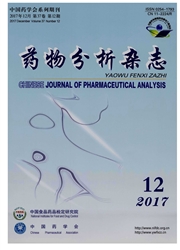

 中文摘要:
中文摘要:
目的:建立UPLC法同时测定葛根芩连汤肠外翻囊样品中6个黄酮类成分(葛根素、大豆苷、甘草苷、野黄芩苷、黄芩苷、汉黄芩苷)的含量。方法:样品用甲醇提取,采用Agilent Proshell 120EC—C18(46mm×50mm,2.7μm)色谱柱,以0.2%醋酸水溶液(A)-甲醇(B)为流动相进行梯度洗脱,流速1mL·min^-1,紫外检测波长270nm,柱温30℃。结果:葛根素、大豆苷、甘草苷、野黄芩苷、黄芩苷、汉黄芩苷质量浓度分别在0.1870—93.50μg·mL^-1(r=n9999),0.2730-13.65μg·mL^-1(r=0.9999),0.02550~12.75μg·mL^-1(r=0.9999),0.05580~27.90μg·mL^-1(r=0.9998),0.2124—106.2μg·mL^-1(r=0.9999),0.09140—45.70μg·mL^-1。(r=0.9999)范围内有良好的线性关系;日间、日内精密度变异均小于2%;平均回收率(n=9)分别为101.4%,97.88%,99.15%,99.72%,98.50%,101.4%;稳定性良好。结论:所建立的分析方法操作简便、快速、灵敏,结果准确,重复性好,所需样品少,并已成功应用于葛根芩连汤大鼠肠吸收动力学的研究。
 英文摘要:
英文摘要:
Objective :To develop a sensitive and selective ultra performance liquid chromatography (UPLC) method for identification and quantification of six flavonoids components ( puerarin, daidzin, liquiritin, seutellarin, baicalin, wogonoside) in rat everted gut sacs. Methods :The method was based on simple liquid -liquid extraction. The separation was performed on a Agilent Proshell 120 EC - C18 (4. 6 mm× 50 mm, 2. 7 μm) column. The mobile consisted of 0. 2% acetic acid aqueous(A) and methanol(B) with a gradient elution at a flow-rate of 1.0 mL · min^-1. The detection wavelength was 270 mn and the column temperature was 30 ℃. Results:The linear ranges of puerarin, daidzin, liquiritin, scutellarin, baiealin, wogonoside were 0. 1870 -93. 50 μg mL^-1 (r =0. 9999) ,0. 02730 - 13. 65 μg· mL^-1 (r =0.9999),0.02550-12.75 μg· mL^-1(r=0.9999),0. 05580 - 27. 90 μg· mL^-1 (r =0.9998),0. 2124-106.2 μg· mL^-1 (r =0. 9999) ,0. 09140 -45. 70 μg· mL^-1 (r =0. 9999), respectively. The intra - and inter -day precisions(RSD) were within 2% for the analytes. The mean recoveries of puerarin, daidzin, liquiritin, scutellarin, baicalin, wogonoside were 101.4%, 97. 88%, 99. 15%, 99. 72%, 98. 50%, 101.4%. Conclusion:The proposed method enables unambiguous identification and quantification for the preliminary pharmacokinetic studies of the compounds ( puerarin, daidzin, liquiritin, scutellarin, baicalin, wogonoside), and has been applied to a intestinal absorption kinetics of Gegenqinlian decoction in rats successfully.
 同期刊论文项目
同期刊论文项目
 同项目期刊论文
同项目期刊论文
 期刊信息
期刊信息
